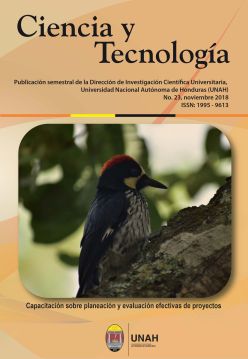Body performance of fish species native to the Gulf of Fonseca of Honduras
DOI:
https://doi.org/10.5377/rct.v0i23.6860Abstract
In the Gulf of Fonseca located in southern Honduras, there are 60 species of fish of commercial value. Some of these are classified as whitefish (where 33% of the total catches are grouped). Whitefish is of little commercial value for artisanal fishermen, but with high viability for primary processing. The objective of the study was to evaluate the indices of corporal performance from 10 fish species native to the Gulf of Fonseca, in order to identify the species with potential for primary processing; which consists in the cleaning and extraction of viscera for commercialization and consumption processes. Post-harvest specimens (with weights between 150 and 500 g) were collected from the Gulf of Fonseca´s native fish located in four fishing communities. Morphometric measurements were recorded or calculate the yields of the carcass, viscera, scales, head, trunk, and fillet. We found conclusive results (P <0.001), being the snapper (Lutjanus spp.), the curvina (Cynoscion spp.), and the mullet (Mujil spp.) with the best carcass performance. The species with the largest volume of viscera was the horse mackerel (P <0.001). In the palometa (Diapterus peruvianus) it was found with the greater weight of the head in relation to its total weight. In the performance of the trunk, the mullet, the curvina and the güiche (Ariopsis spp.) presented the highest muscle mass (more than 65% of their body weight). Regarding the yield of the fillet, the curvina (Cynoscion spp.), the güiche (Ariopsis spp.), and the striped
pancha (Paralonchurus dumerilii) showed more than 38% yield, evidencing that they have a better potential to be processed into fillet and therefore, are more attractive to the market value.
Downloads
2303
Downloads
Published
How to Cite
Issue
Section
License
© Revista Ciencia y Tecnología
Authors who publish in this journal accept the following conditions: In accordance with the legislation of copyright, Revista Ciencia y Tecnología, recognizes and respects the moral right of authors, as well as the ownership of the patrimonial right, which will be ceded to the magazine for its diffusion in open access in printed version and in digital format. By being part of multiple indexers, databases and reference systems, the articles published by Revista Ciencia y Tecnología will be visible and will be downloaded from these websites, indicating, in all cases, the authorship of the articles, the date of publication and the number of the journal to which they correspond.




